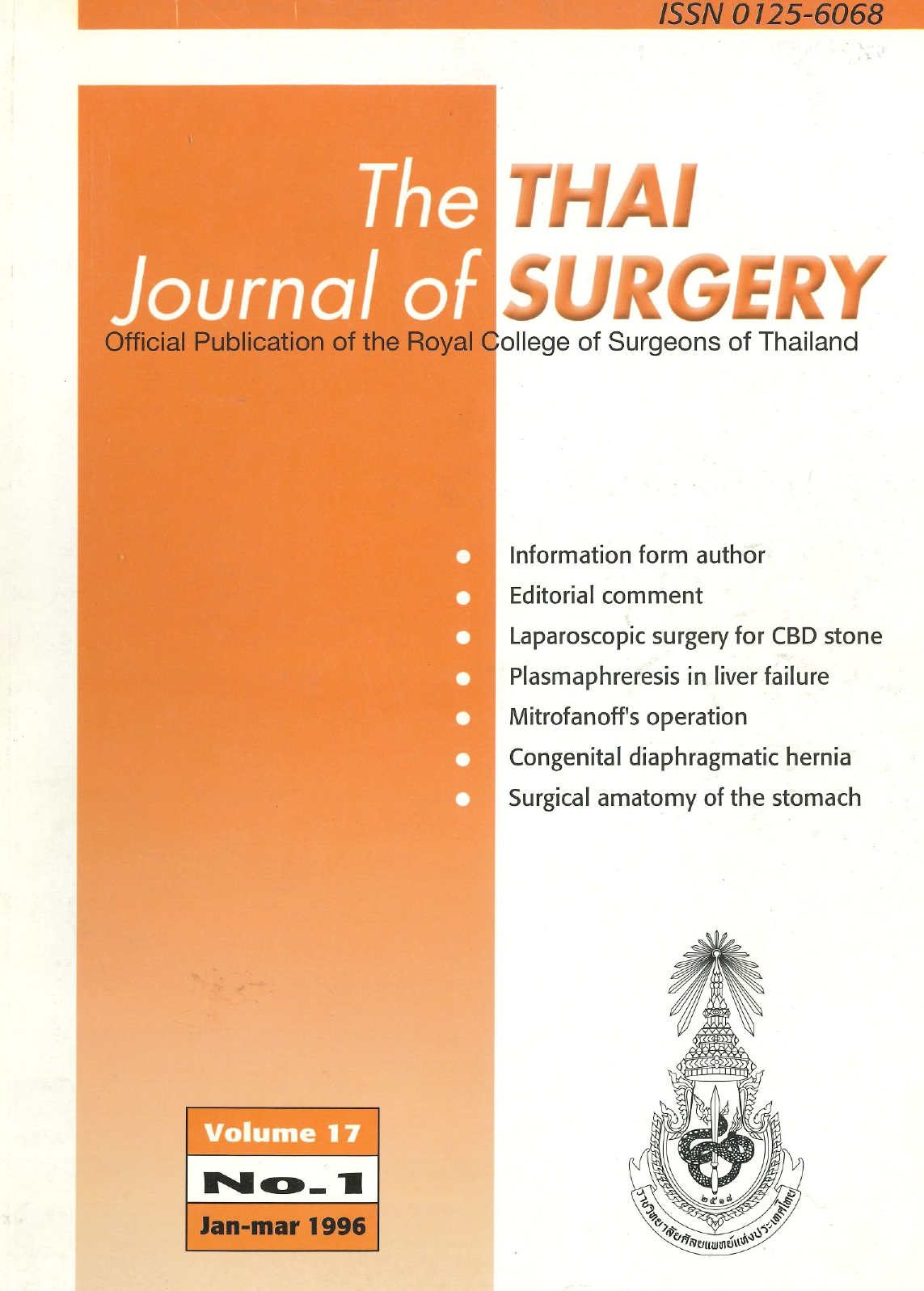Congenital Diaphragmatic Hernia
Keywords:
Congenital diaphragmatic hernia, extracorporeal membrane oxygenator respirator distressAbstract
This is a collective review of the literatures about congenital diaphragmatic hernia. Advances over the years have changed the way in which congenital diaphragmatic hernia is diagnosed and treated. If the diagnosis is made before birth, the mother should be transported to a tertiary hospital. Martenal transport of the fetus is much safer than the baby. But despite advances in infant transport and intensive care, congenital diaphragmatic hernia (CDH) still poses a serious threat to life during the neonatal period. Understanding the pathophysiology of congenital diaphragmatic hernia and its devastating effects on the lungs' bronchial and vascular development assists the physician in rational management during the perioperative period. Patients require immediate and appropriate stabilization. CDH is not necessarily a surgical emergency because repair does not allow expansion of the lung and does not improve the clinical picture. Improvements in ventilatory support and pharmacologic management of pulmonary hypertension have allowed surgeons to delay repair until circulatory hemodynamics, electrolytes, and oxygenation can be optimized. Surgery may actually worsen pulmonary mechanics and lead to pulmonary hypertension. Successful treatment demands prompt diagnosis, informed preoperative assessment and preparation, carefully timed surgical repair, and aggressive postoperative intensive care with a thorough understanding of the role of ECMO. In the future, early fetal intervention or lung transplantation may be included as standard therapy for patient with severe lung hypoplasia, but now these areas remain controversial and experimental. Clinical experience is limited.
References
2. มงคล เลาหเพ็ญแสง. ไส้เลื่อนกระบังลมแต่กำเนิด. ใน: ไพบูลย์ สุทธิวรรณ. บรรณาธิการกุมารศัลยศาสตร์. กรุงเทพฯ: โรงพิมพ์เรือนแก้วการพิมพ์ 2536: 91-121
3. Sadler TW. Body Cavities and Serous Membranes, In; Sadler TW, ed, Langman's Medical Embryology, 5th ed. Baltimore: Williams & Wilkins 1985:154-68
4. Cullen ML. Klein MD, Philippart AI. Congenital Diaphragmatic Hernia. Surg Clin North Am 1985;65:1115-38
5. Weinstein S. Stolar CJH. Newborn Surgical Emergencies, Pediatr Clin North Am 1993:40:1315-33
6. Puri P, Gorman WA. Natural history of congenital diaphragmatic hernia: implication for management. Pediatr Surg Int 1987:2:327-30
7. Adzick NS. Harrison MR, The Unborn Surgical Patient. Curr Probl Surg 1994:31:1-68
8. Kitagawa M, Hislop A. Lung hypoplasia in congenital diaphragmatic hernia: A quantitative study of airway, artery and alveolar development, Br J Surg 1971:58:342-6
9. Geggel M, Murphy JD, Langleben D, et al. Congenital diaphragmatic hernia: Arterial structural changes and persistent pulmonary hypertension after surgical repair. J Pediatr 1987;107:457-63
10. Glick PL. Stannard VA. Leach CL, et al. Pathophysiology of congenital diaphragmatic hernia ll: the fetal lamb CDH model is surfactant deficient. J Pediatr Surg 1992;27:3828
11. Sullivan KM. Hawgood S. Flake AW, et al. Amniotic fluid phospholipid analysis in the congenital diaphragmatic hernia fetus. J Pediatr Surg 1993;28:1168-72
12. Suen HC. Catlin EA, Wain JC, et al, Biochemical immaturity of lungs in congenital diaphragmatic hernia. J Pediatr Surg 1993;28:471-7
13. Hratch LK. Glick PL, Duncan T, et al. Pathophysiology of congenital diaphragmatic hernia XI: Anatomic and biochemical characterization of the heart in the fetal lamb CDH model. J Pediatr Surg 1995:30:925-9
14. Hassett MU, Glick PL, Karamanoukian HL et al. Pathophysiology of congenital diaphragmatic hernia XVI: Elevated pulmonary collagen in the lamb model of congenital diaphragmatic hernia. J Pediatr Surg 1995;30:1191-4
15. Irving IM. Booker PD. Congenital diaphragmatic hernia and eventration of the diaphragm. In: Lister J. Irving IIM, eds. Neonatal Surgery, 3rd ed. London: Butterworths 1990;199-220
16. Butler MW. Stolar CJH, Altman RP. Contemporary management of congenital diaphragmatic hernia. World J Surg 1993;17:350-5
17. Kinsella JP. Neish SR, Shaffer E. Abman SH. Low dose inhalation nitric oxide in persistent pulmonary hypertension of the newborn. Lancet 1992;340:819-20
18. Bax NMA. Collins DL. The advantages of reconstruction of the dome of the diaphragm in congenital posterolateral defects. J Pediatr Surg 1984:19:484-7
19. Price MR, Galantowicz ME, Stolaz CJ. Congenital diaphragmatic hernia extracorporeal membrane oxygenator and death: a spectrum of etiologies. J Pediatr Surg 1991;28:1023-7
20. Stack F. Geven W. Oeseburg B, et al. Experience with delayed repair of congenital diaphragmatic hernia during extracorporeal membrane oxygenation in a Euopean centre. Pediatr Surg Int 1993:8:187-90
21. Nagaraj HS. Mitchell KA, Fallat ME, et al. Surgical complications and procedures in neonates on extracorporeal membrane oxygenation. J Pediatr Surg 1992:27:1106-9
22. Cromblehome TM. Adzick NS, Hardy K. Pulmonary lobar transplantation in neonatal swine: a model for treatment of congenital diaphragmatic hernia. J Pediatr Surg 1990:25:11-8
23. Towokian RJ. Markowitz RI. A preoperative scoring system for risk assessment of newboms with congenital diaphragmatic hernia. J Pediatr Surg 1934:19:252 -7
24. Hatch El Jr. Kendall J, Blumhagen J. Stomach position as an in utero predictor of neonatal outcome in left sided diaphragmatic hernia. J Pediatr Surg 1992:27:778-9
25. Weiner ES. Congenital diaphragmatic hernia: new dimensions in management. Surgery 1982:92:669-81
26. Krummel TM, Greenfield LJ, Kirkpatrick BV, et al. Alveolar-arterial oxygen gradients versus the neonatal pulmonary insufficiency index for the prediction of mortaliry in ECMO candidates. J Pediatr Surg 1984:1 9:380-4
27. Bohn D. Tamuru M. Perrin D, et al, Ventilatory predictors of pulmonary hypoplasia in congenital diaphragmatic hernia, confirmed by morphologic assessment. J Pediatr 1987:111:423-31
28. Wiison JM. Lund DP, Lillehei CW,et al. Congenital diaphragmatic hernia: predictors of severity in ECMO era. J Pediatr Surg 1991:26:1028-33
29. Harrison MR. Langer JC, Adzick NS, et al. Correction of congenital diaphragmatic hernia in utero V.Initial clinical experience. J Pediatr Surg 1990:25:47-55
30. DiFiore JW, Fauza DO, Slavin R, et al. Experimental feta tracheal ligation reverses the structural and physiological effects of pulmonary hypoplasia in congenital diaphragmatic hernia. J Pediatr Surg 1994:29:248-57
Downloads
Published
How to Cite
Issue
Section
License
Articles must be contributed solely to The Thai Journal of Surgery and when published become the property of the Royal College of Surgeons of Thailand. The Royal College of Surgeons of Thailand reserves copyright on all published materials and such materials may not be reproduced in any form without the written permission.



